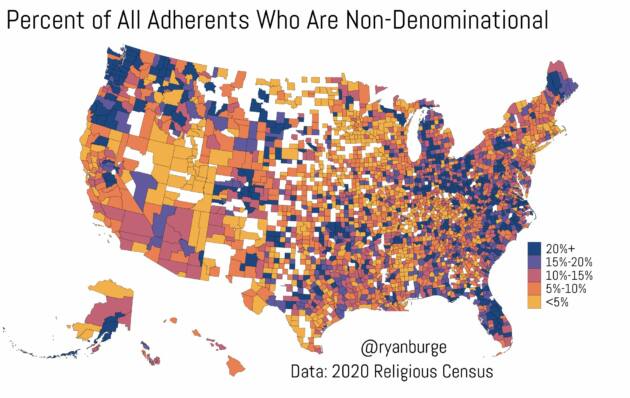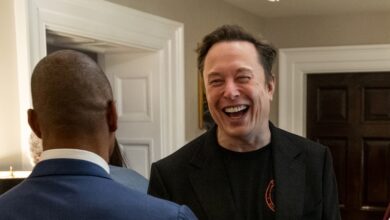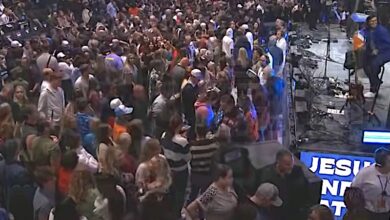Rise of the ‘nons’ is shaking the American religious landscape

“The two biggest stories in American religion are the nones and the nons,” premier numbers guy Ryan Burge told Christianity Today.
Nones, so prominent in the media this past decade, are those increasing Americans who tell pollsters they have no religious identity or affiliation.
Who are the Nons?
But nons? They’re nondenominational Protestants whose local congregations are wholly self-governing and independent of traditional denominations. A blockbuster in the November U.S. Religion Census report said that taken together, they number 21 million and are unquestionably the largest U.S. Protestant group, exceeding by millions the largest denomination, the Southern Baptist Convention, and second only to Catholics.
This is a story that is everywhere. There are 44,319 “nons” congregations, an increase of 8,823 since 2010, and this crowd now claims more than 13% of the nation’s churchgoers.
At the end of a hectic 2022, we could proclaim the now-documented rise of the nons the Story of the Year, one that local and national media need to be pursuing. This development was quickly highlighted by Daniel Silliman of Christianity Today and Tracy Simmons for Religion Unplugged. Summarized CT, “Little noticed, they have been quietly reworking the religious landscape.”
Most such congregations are evangelical (or charismatic-Pentecostal) and they are young. Although many are modest in size, they’re prominent on the Outreach100 list of the largest U.S. Protestant congregations.
Thus, this is a story that is local, regional and national. Think Highlands in Birmingham, Lakewood in Houston, Crossroads in Cincinnati, Christ Fellowship in Palm Beach or North Point outside Atlanta. One celebrated example, Willow Creek in suburban Chicago, now ranks 69th among the megachurches.
As GetReligion’s Terry Mattingly observes, these independents often lack “even minimal legal, financial, ethical or theological oversight” from authorities outside their bubbles, and often the founding preacher wields “complete control, with a hand-picked board as the only balance on his power.” Scandals can result.
Rising alongside the nons, the much-celebrated nones constituted a mere 5.1% of Americans in 1972 but zoomed to 23.7% as of 2018 in General Social Survey data. Other sources post higher percentages than that. This largely reflects the unprecedented slide of those identifying with predominantly White and religiously flexible mainline Protestant denominations that GSS put at 27.9% of Americans in 1972 and a disastrous 9.9% by 2018 — with the decline speeding up during the coronavirus pandemic.
Political scientist and American Baptist pastor Burge wrote the book — literally — on the nones, and a second edition of his perceptive 2021 work is due next May. Journalists also need to focus on what Burge therein identifies as “the fastest-growing religious group in the United States today.” That would be “nothing in particular” folks, a flock this Memo will label “NIPs.”
Big difference on Nons et al
To explain, polls often lump together all religiously unaffiliated respondents as “nones,” but Burge stresses the differences among three groups that are often separated out in, for instance, Pew Research surveys. Atheists are convinced God does not exist. Agnostics either do not themselves know or think nobody can know. Both are small and stable populations.
The rising NIPs, by far the biggest niche among nones, simply claim no specific identity or affiliation — so “nothing in particular.”
Burge stresses that NIPs are substantially different from the other two “none” categories, less educated, less affluent, more politically conservative, uninvolved not only with churches but all community activities, and less hostile toward religion. He sees the socially disengaged NIPs as the prime target for Christians’ 21st century outreach.
Let’s not neglect yet another group identified in the title of this brand-new book: “Nonverts: The Making of Ex-Christian America.” Author Stephen Bullivant, a British sociologist who is Catholic, defines nonverts as Americans who were raised religious and convert to “none” status, as opposed to those continuing their nonreligious backgrounds.
Why did this upheaval occur recently and not during the anti-establishment 1960s? Bullivant identifies such factors as a backlash against “religious right” politicking, the end of shared Cold War enemies, the internet’s linking of isolated skeptics and that more nones exist simply because there are more nones(!). More here.
The U.S. Religion Census has been conducted once per decade since 1990 by the Association of Statisticians of American Religious Bodies. Its data gain importance with the demise of the standard annual yearbook compilation of church groups’ own numbers, issued for 96 years until the financially strapped National Council of Churches ceased publication in 2012.
–Richard Ostling is a former religion reporter for The Associated Press and former correspondent for TIME Magazine. This piece first appeared at Get Religion. Used with permission.








